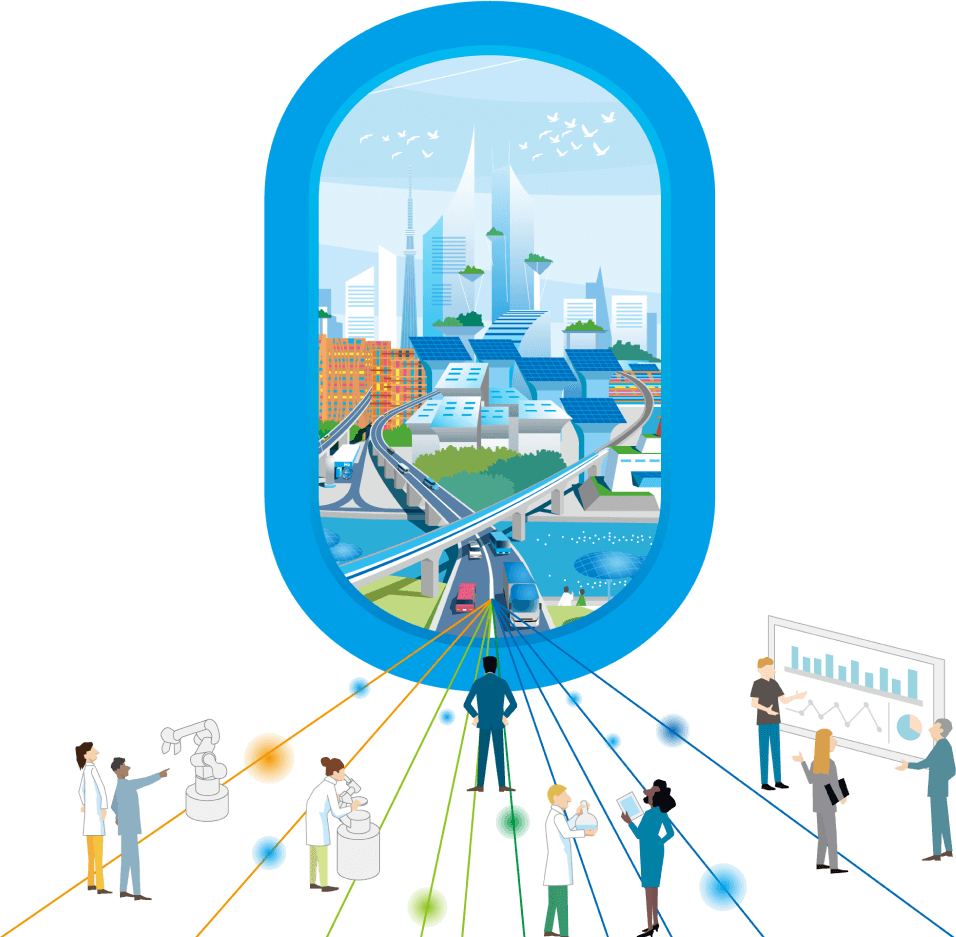Fundamentals of Ionic Devices Research Team
Employing structural control and advanced analyses at the nanolevel to develop electrolyzers, fuel cells, and other electrochemical devices that are crucial for realizing a zero-emission society.

Research themes
- Technologies for highly efficient conversion of CO₂, water, and renewable energy into chemicals
- High-performance solid oxide electrolysis cells (SOECs) and elucidation of their degradation factors
- Development of new electrochemical devices utilizing high-temperature ionic conductors

Research Team Leader / Greetings
KISHIMOTO Haruo
We are called Team FINDER (Fundamentals of Ionic Devices Research Team). We specialize in unraveling the behavior of ions and electrons through electron microscopy and related techniques. By uncovering hitherto unseen phenomena, we hope to contribute to the realization of an exciting zero-emission society.
Members
OKAZAKI Moe
Introduction
To realize a “zero-emission society,” it is necessary to deploy large-scale power generation utilizing renewable energies which do not emit CO2, such as photovoltaics (PV) and wind power. On the other hand, due to fluctuations in power generation caused by intermittent weather and other factors, it is also necessary to develop technologies for efficient energy storage and transport.
Electrochemical devices, such as electrolyzers and fuel cells, are capable of converting electrical energy into chemical energy and vice versa, are essential technologies for storing and transporting energy.
Electrochemical devices consist of layers of different materials. Energy conversion takes place via electrochemical reactions and ion and electron transport which occur on the surfaces of materials and at the boundaries/interfaces between materials. What are the surfaces and interfaces of the materials like? When a device is operating, what happens at the interfaces? The answers will lead to improved performance of electrochemical devices.
Research content
Our team conducts fundamental research aimed at improving performance, functionality, and reliability of electrochemical devices such as electrolyzers and fuel cells. In line with this goal, we design and fabricate heterointerfaces and device configurations, and characterize them using advanced analyses to elucidate the mechanisms governing physical properties and degradation, leading to the development of high-performance cells.

①High-efficiency energy conversion system with SOEC technology
Compared to other types of electrolyzers, solid oxide electrolysis cells (SOECs) are characterized by high efficiencies for manufacturing hydrogen by effectively using heat. Unlike other electrolyzers, it has the capability to simultaneously electrolyze steam and CO2 (co-electrolysis, refer to the left-hand side of the schematic illustration below). Since an oxide ion (O2-) conductor is used as the electrolyte, when steam and carbon dioxide are introduced together into the fuel electrode, oxygen is removed not only from steam but also from the carbon dioxide, allowing synthetic gas (syngas, a mixture of hydrogen and carbon monoxide) to be produced.
In addition, by successfully combining this co-electrolysis process to produce fuels such as methane from syngas, approximately 90% of the electricity used for electrolysis can be converted to chemical energy. If electricity derived from renewables is used as the external power source, it is possible to synthesize carbon-neutral methane (e-methane) and other fuels with high efficiency (see right-hand side of the schematic illustration below).
Since FY2022, we have been collaborating with Osaka Gas Co., Ltd. on the NEDO Green Innovation Fund project, aimed at the early commercialization of innovative e-methane production.

②Development of electrochemical devices with controlled nanostructures and heterointerfaces
In solid oxide fuel cells (SOFCs) and solid oxide electrolysis cells (SOECs), oxygen is incorporated as oxide ions (O2-) at electrode surfaces, which then flow through the electrolyte, and migrate to the opposite electrode. Our team is developing materials with high electrode reactivity and high ionic transport properties by tuning nanostructures and interfaces using thin-film fabrication techniques.
We have developed self-assembled nanocomposite air electrodes by tuning nanostructures and developing their optimal use and have achieved the world’s highest power output in a single SOFC cell. (Figure)

Also, from visualizing the flow of oxide ions (O2-) at heterointerfaces, we have identified regions which inhibit ionic flow and improved performance by their mitigation. (Figure)

③Elucidation of factors governing functionalities and degradation mechanisms of electrochemical devices using advanced analyses
We are elucidating factors governing functionalities and degradation phenomena of electrochemical devices by utilizing advanced analyses such as high-throughput processing/analysis equipment (plasma FIB-SEM), high mass resolution/high spatial resolution secondary ion mass spectrometry (NanoSIMS), and non-destructive high-resolution three-dimensional X-ray computed tomography (X-ray CT). Through collaboration with other groups within the institute, international collaboration with overseas research institutions, and joint research projects with companies, we are working to elucidate degradation phenomena of SOFC, SOEC, and other electrochemical devices and contribute to early social implementation of these technologies.
Goals of the Fundamentals of Ionic Devices Research Team
Our team is called the FINDER Team (Fundamentals of Ionic Devices Research Team). We specialize in uncovering and discovering hitherto unknown phenomena, and elucidating the behavior of ions and electrons.
We believe it is important to promote collaborative research with domestic and global companies and research institutions to create innovations that bring about higher performance and functionality in electrochemical devices that contribute to the realization of a zero-emission society. If you are interested in our work, please contact us.
Video
Research
Research Teams
- Thermal Energy Device Research Team
- Fundamentals of Ionic Devices Research Team
- Artificial Photosynthesis Research Team
- Carbon-based Energy Carrier Research Team
- Carbon Management Research Team
- Resource Circulation Technology Research Team
- Environmental Impact Research Team
- Environmental and Social Impact Assessment Team
- Data-Driven Smart Society Systems Research Team




